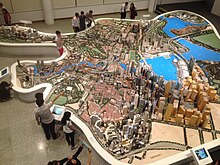
The Urban Redevelopment Authority (URA) is the national urban planning authority of Singapore, and a statutory board under the Ministry of National Development of the Government of Singapore.

Marina Bay is a bay located in the Central Area of Singapore, surrounded by the perimeter of four other planning areas, the Downtown Core, Marina East, Marina South and Straits View. The area surrounding the bay itself, also called Marina Bay, is a 360 hectare extension to the adjacent Central Business District. It is also the new downtown of Singapore, built on reclaimed land.

Republic Plaza is a skyscraper in Downtown Core, Singapore. It comprises two towers and a 10-storey podium. The first tower, Republic Plaza I, has 66 floors and a height of 280 metres (920 ft), and has a varying octagonal-cross section, while its interior allows for flexible space usage by tenants. The second tower, Republic Plaza II, is 23 stories tall, while the podium contains a three-floor retail area.

The Parliament House is a public building and a cultural landmark in Singapore. It houses the Parliament of Singapore, and is located in the Civic District of the Downtown Core within the Central Area. Within its vicinity is Raffles Place, which lies across from the Parliament House from the Singapore River, and the Supreme Court's building across the road. The building was designed to represent a contemporary architectural expression of stateliness and authority. The prism-shaped top, designed by President Ong Teng Cheong, was similarly a modernist take on the traditional dome.

The Science Centre Singapore, previously known as Singapore Science Centre is a scientific institution in Jurong East, Singapore, specialising in the promotion of scientific and technological education for the general public. It houses over 850 exhibits over eight exhibition galleries and receives over a million visitors every year. In 2003, it celebrated its silver jubilee.

The Istana Park is a park in Singapore, located in the Museum Planning Area within the Central Area, Singapore's central business district. The park is bounded by Orchard Road, Penang Road, Penang Lane and Buyong Road.
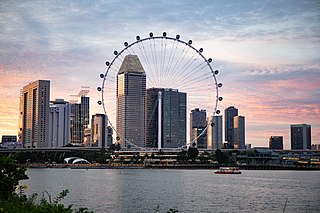
This article shows the notable future developments in Singapore. Most of them are currently under construction with most to be completed within the next five years.

The former Asia Insurance Building, now named Ascott Raffles Place, lies in the heart of the Central Business District of Singapore, at the corner of Finlayson Green and Raffles Quay. Standing at 270 feet, it surpassed the Cathay Building to be the tallest tower in Singapore until the completion of Meritus Mandarin Tower 1 in 1971. Designed by one of Singapore's pioneer architects, Ng Keng Siang, the office building was completed in 1955 and served as the headquarters for the Asia Insurance Company, one of the first local insurance companies. In 2006, the building was acquired by the Ascott Group and the office tower has since been refurbished into a serviced apartment residence. Renamed as Ascott Raffles Place, the building sits on a 999-year leasehold site with a building footprint of about 950 square meters.

The Fullerton Hotel Singapore is a five-star luxury hotel located near the mouth of the Singapore River, in the Downtown Core of the Central Area, Singapore. It was originally known as the Fullerton Building, and also as the General Post Office Building. The address is 1 Fullerton Square. The Fullerton Building was named after Robert Fullerton, the first Governor of the Straits Settlements (1826–1829). Commissioned in 1924 as part of the British colony's centennial celebrations, the building was designed as an office building by Major P.H. Keys of Keys & Dowdeswell, a Shanghai firm of architects, which won the project through an architectural design competition. The architectural firm also designed the Capitol Theatre, its adjoined Capitol Building and the Singapore General Hospital. In 2015, it was designated as a national monument of Singapore.

Yue Hwa Building is a historic building located at the junction of Eu Tong Sen Street and Upper Cross Street in Chinatown, Singapore, next to Chinatown MRT station. Built by Swan and Maclaren in 1927, it was then the tallest building in Chinatown and was known as Nam Tin Building (南天大厦), owned by Lum Chang Holdings. The building housed the six-storey Great Southern Hotel, along with a few shops and cabarets that were popular among Chinese travellers. In 1993, Lum Chang Holdings sold the building to Hong Kong businessman Yu Kwok Chun, who converted it to the first Yue Hwa Chinese Products department store in Singapore in 1994. The renovation process, which conserved the exterior while adding features such as an atrium and waterfall to the interior, won the building the Architectural Heritage Award by the Urban Redevelopment Authority in 1997.
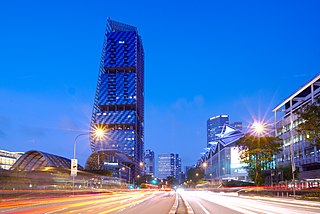
South Beach is a commercial and residential complex located on Beach Road in the Downtown Core of Singapore. It is composed of a hotel tower managed by JW Marriott Hotels, an office tower, shops and residences. The project includes the restoration of four conservation buildings – the former Non-Commissioned Officers' Club building and part of the former Beach Road Camp. It is accessible from Esplanade MRT station.

Gallery Hotel was a four-star boutique hotel at Robertson Quay on Singapore River, in the Central Area of Singapore. Originally known as Gallery Evason Hotel, it was the first "HIP" hotel in Singapore, and the second in Asia, the first being in Japan.

The Ministry of National Development is a ministry of the Government of Singapore responsible for the formulation and implementation of policies related to the land-use planning and infrastructure development in Singapore.
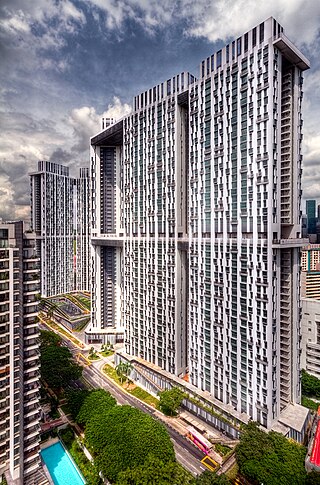
The Pinnacle@Duxton is a 50-storey residential development in Singapore 's city center, next to the business district. All seven connected towers are collectively the world's tallest public residential buildings, and featuring the two longest sky gardens ever built on skyscrapers, at 500m each.

Jurong Lake District is a district of Singapore, planned as part of Urban Redevelopment Authority (URA)’s decentralisation efforts to bring more quality jobs, amenities, and recreational options closer to homes. The plans for the district have continued to evolve since the blueprint was first unveiled in the URA Master Plan 2008. It consists of three precincts, namely Jurong Gateway, Lakeside and Lakeside Gateway. It is 472 hectares (4,720,000 m2) in size and served by two major expressways and three MRT stations. It will be the Singapore's next central business district. In June 2023, a white site 6.5 hectares (ha) in size was released for sale to kick-start development of the largest commercial district outside Singapore’s city centre.

Marina One is a mixed-use development bounded by Marina Way and Straits View in Marina South located within the Downtown Core of the city-state of Singapore.
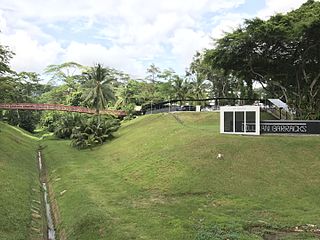
Gillman Barracks is a contemporary arts cluster in Singapore that is home to international art galleries, restaurants and the NTU Centre for Contemporary Art Singapore, which are all housed in conserved colonial barracks. Gillman Barracks lies near to Alexandra Road, and the 6.4-hectare (16-acre) site covers Lock Road and Malan Road amid greenery. Gillman Barracks is jointly developed by the Singapore Economic Development Board, JTC Corporation and the National Arts Council.

Straits View is a planning area located in the Central Area of the Central Region of Singapore. The area is currently relatively undeveloped, with fewer commercial developments compared to the adjacent Downtown Core.

Sculpture Square was a non-profit arts organization located at 155 and 161 Middle Road, Singapore. It was founded by sculptor Sun Yu-Li in 1995 as a venue with the focus on exhibiting and fostering ‘3-dimensional’ and other forms of sculptural arts in Singapore.


